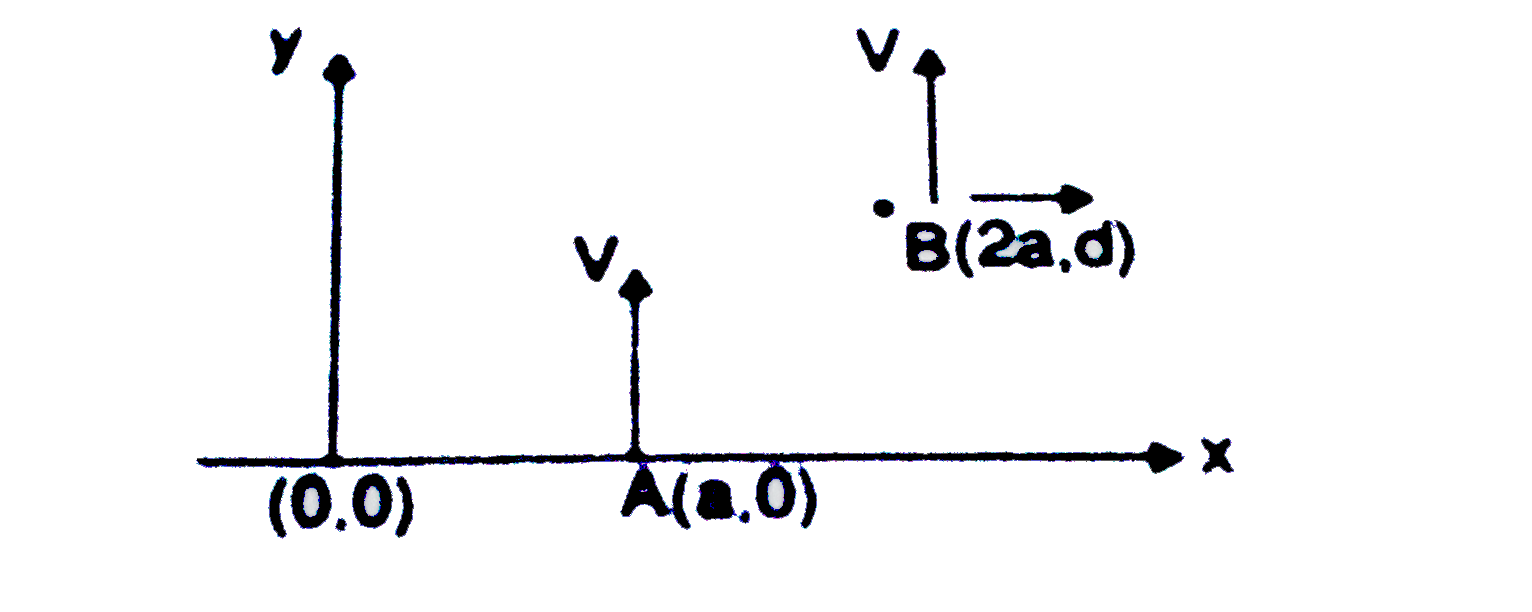There exists a uniform electric field between plates A and B. An electron and proton, initially at rest are released from plates A and B respectively. If ae and ap stand for the acceleration of electron and proton respectively then
ae=ap
ae<ap
ae>ap
ae=ap/2
To solve the problem, we need to analyze the forces acting on the electron and proton in the uniform electric field and relate their accelerations.
1. Understanding the Forces:
- The force acting on a charged particle in an electric field is given by the equation:
F=qE
where F is the force, q is the charge of the particle, and E is the electric field strength.
2. Identifying Charges:
- The charge of an electron (qe) is −e (negative charge).
- The charge of a proton (qp) is +e (positive charge).
3. Calculating Forces:
- For the electron:
Fe=qeE=−eE
- For the proton:
Fp=qpE=eE
4. Applying Newton's Second Law:
- According to Newton's second law, the force is also equal to mass times acceleration:
F=ma
- For the electron:
Fe=meae⟹−eE=meae⟹ae=−eEme
- For the proton:
Fp=mpap⟹eE=mpap⟹ap=eEmp
5. Comparing Accelerations:
- Now we have expressions for the accelerations:
ae=−eEme
ap=eEmp
- To compare ae and ap, we can analyze the magnitudes:
|ae|=eEme,|ap|=eEmp
6. Mass Comparison:
- The mass of the electron (me) is much smaller than the mass of the proton (mp):
me<mp
- Since acceleration is inversely proportional to mass, we conclude:
|ae|>|ap|
7. Final Conclusion:
- Therefore, the acceleration of the electron is greater than the acceleration of the proton:
ae>ap
Final Answer:
The acceleration of the electron (ae) is greater than the acceleration of the proton (ap).
- The force acting on a charged particle in an electric field is given by the equation:
F=qE
where F is the force, q is the charge of the particle, and E is the electric field strength.
- The charge of an electron (qe) is −e (negative charge).
- The charge of a proton (qp) is +e (positive charge).
- For the electron:
Fe=qeE=−eE
- For the proton:
Fp=qpE=eE
- According to Newton's second law, the force is also equal to mass times acceleration:
F=ma
- For the electron:
Fe=meae⟹−eE=meae⟹ae=−eEme
- For the proton:
Fp=mpap⟹eE=mpap⟹ap=eEmp
- Now we have expressions for the accelerations:
ae=−eEme
ap=eEmp
- To compare ae and ap, we can analyze the magnitudes:
|ae|=eEme,|ap|=eEmp
- The mass of the electron (me) is much smaller than the mass of the proton (mp):
me<mp
- Since acceleration is inversely proportional to mass, we conclude:
|ae|>|ap|
- Therefore, the acceleration of the electron is greater than the acceleration of the proton:
ae>ap
The acceleration of the electron (ae) is greater than the acceleration of the proton (ap).
Topper's Solved these Questions
Similar Questions
A proton and an electron are accelerated by the same potential difference, let λe and λp denote the de-Broglie wavelengths of the electron and the proton respectively
View SolutionIn a region of uniform electric field ofn intencity E, an electron of mass me is released from rest. The distance travelled by the eloctron in a time t is
View SolutionAn electron of mass m and charge e initially at rest gets accelerated by a constant electric field E. The rate of change of de-Broglie wavelength of this electron at time t ignoring relativistic effects is
View SolutionAn electron, a proton and an alpha particle have kinetic energy of 16E,4E and E respectively. What is the qualitavtive order of their de Broglie wavelengths :-
View SolutionA proton and an electron are placed in a uniform electric field.
View SolutionAn electron (mass me)falls through a distance d in a uniform electric field of magnitude E.
 ,
,
The direction of the field is reversed keeping its magnitudes unchanged, and a proton(mass mp) falls through the same distance. If the times taken by the electrons and the protons to fall the distance d is telectron and tproton respectively, then the ratio telectron/tproton.
View SolutionThe formula of a compound is A2B5. The number of electrons in the outermst shells of A and B respectively are:
View SolutionAn electron, a proton and an alpha particle have KE of 16E, 4E and E respectively. What is the qualitative order of their de-Broglie wavelengths?
View SolutionAn electron and a proton are in uniform electic field. The ratio of their acceleration will be
View SolutionA uniform electric field of strength e exists in a region. An electron (charge -e, mass m) enters a point A with velocity Vˆj. It moves through the electric field & exits at point B. Then :

View Solution
